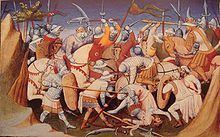Period 1529 – 1543 | Location Ethiopia | |
 | ||
Combatants Ethiopian Empire, Ottoman Empire, Portuguese Empire, Kingdom of Portugal Similar Ottoman–Portuguese conflicts, Ethiopian Civil War, Ogaden War, 2007–08 Ethiopian crackdow, Second Italo‑Ethiopian War | ||
Abyssinian adal war
The Abyssinian–Adal war was a military conflict between the Ethiopian Empire and the Adal Sultanate that took place from 1529 until 1543. Abyssinian troops consisted of Amhara, Tigrayan and Agew tribes. Adal forces consisted of Harla (Hararis) and Somali tribes.
Contents
Background
Islam was introduced to the Horn of Africa early on from the Arabian peninsula, shortly after the hijra. In the late 9th century, Al-Yaqubi wrote that Muslims were living along the northern Somali seaboard. He also mentioned that the Adal kingdom had its capital in the city, suggesting that the Adal Sultanate with Zeila as its headquarters dates back to at least the 9th or 10th centuries. According to I.M. Lewis, the polity was governed by local dynasties consisting of Somalized Arabs or Arabized Somalis, who also ruled over the similarly-established Sultanate of Mogadishu in the Benadir region to the south. Adal's history from this founding period forth would be characterized by a succession of battles with neighbouring Abyssinia.
Between 1529 and 1543, the military leader Imam Ahmad ibn Ibrahim al-Ghazi defeated several Ethiopian emperors and embarked on a conquest referred to as the Futuh Al-Habash ("Conquest of Abyssinia"), which brought three-quarters of Christian Abyssinia under the power of the Muslim Sultanate of Adal. With an army mainly composed of Somalis, Al-Ghazi's forces and their Ottoman allies came close to extinguishing the ancient Ethiopian kingdom. However, the Abyssinians managed to secure the assistance of Cristóvão da Gama's Portuguese troops and maintain their domain's autonomy. Both polities in the process exhausted their resources and manpower, which resulted in the contraction of both powers and changed regional dynamics for centuries to come. Many historians trace the origins of hostility between Somalia and Ethiopia to this war. Some scholars also argue that this conflict proved, through their use on both sides, the value of firearms such as the matchlock musket, cannons and the arquebus over traditional weapons.
Course of the war
In 1529, Imam Ahmad's Adal troops defeated a larger Ethiopian contingent at the Battle of Shimbra Kure. The victory came at a heavy cost but it solidified the Adal forces' morale, providing proof that they could stand up to the sizable Ethiopian army.
The victories that gave the followers of Imam Ahmad the upper hand came in 1531. The first was at Antukyah, where cannon fire at the start of the battle panicked the Ethiopian soldiers. The second was on 28 October at Amba Sel, when troops under the Imam not only defeated but dispersed the Ethiopian army and captured items of the Imperial regalia. These victories allowed the army to enter the Ethiopian highlands, where they began to sack and burn numerous churches, including Atronsa Maryam, where the remains of several Emperors had been interred. The country was looted by the Ahmad's forces, who destroyed several Christian monuments and oppressed the non-Muslim Amhara and Tigray.
Dawit II died in 1540 and his heir was captured by the forces of Imam Ahmad; the Empress was unable to react as she was besieged in the capital. In 1543, Ethiopian guerrillas were able to defeat the army with the help of the Portuguese navy and the Medri Bahri Kingdom (present day Eritrea), which brought 400 musketeers led by Cristóvão da Gama from Massawa which was controlled by the Medri Bahri Kingdom. The Medri Bahri Kingdom brought 500 musketeers led by Bahri Negassi Yeshaq. Yeshaq not only provided the Portuguese with provisions and places to camp in their realm, but also information about the land. The Bahr negus also joined Emperor Gelawdewos and the Portuguese in the decisive Battle of Wayna Daga, where Imam Ahmad was killed and his forces scattered. The Ethiopian/Portuguese/Medri Bahri force consolidated their victory by ambushing and destroying a second force under one of the Imam's subordinates. This turned the war around. The surviving army were forced to withdraw from Ethiopia, leaving both kingdoms severely weakened.
Aftermath
Mohammed Hassan has plausibly argued that because the participants in this conflict weakened each other severely, this provided an opportunity for the Oromo people to migrate into the lands south of the Abay east to Harar and establishing new territories.
